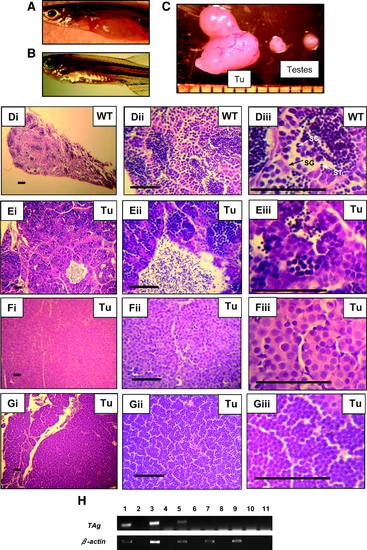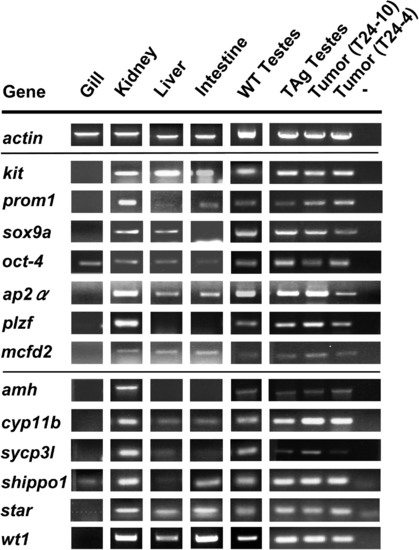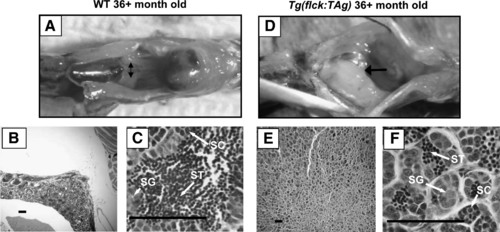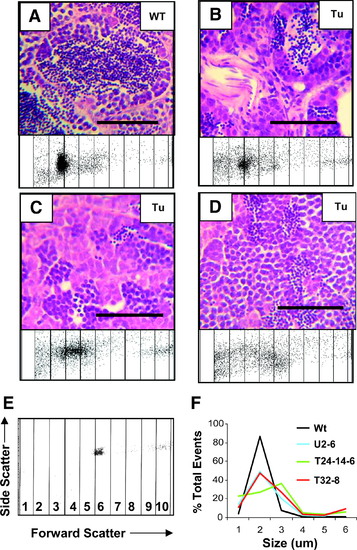- Title
-
Enforced expression of simian virus 40 large T-antigen leads to testicular germ cell tumors in zebrafish
- Authors
- Gill, J.A., Lowe, L., Nguyen, J., Liu, P.P., Blake, T., Venkatesh, B., and Aplan, P.D.
- Source
- Full text @ Zebrafish

ZFIN is incorporating published figure images and captions as part of an ongoing project. Figures from some publications have not yet been curated, or are not available for display because of copyright restrictions. PHENOTYPE:
|
|
Characterization of abdominal tumors. (A) Gross photo of flck:TAg zebrafish with abdominal tumor. (B) WT male zebrafish for comparison (C) testicular germ cell tumor (Tu) compared to WT testes. Size scale is in mm. (Di–Diii) Hematoxylin and eosin-stained testis from WT fish at low, medium, and high power, respectively. Scale bar is 50 μm in all photos. Spermatogonia (SG), spermatocytes (SC), and spermatids (ST) are indicated in (Diii). (Ei–Eiii) TGCT from flck:TAg fish T32(25), same magnifications as above. Note wide spectrum of different cell sizes and morphology. (Fi–Fiii) TGCT from flck:TAg fish T24 (10), same magnifications as above. Note the uniform population of cells with abundant eosinophilic cytoplasm and a low nuclear-to-cytoplasmic ratio, consistent with spermatogonial cells. (Gi–Giii) TGCT from flck:TAg fish T24(4), same magnifications as above. Note the uniform population of basophilic cells with a high nuclear-to-cytoplasmic ratio, consistent with spermatocytes. (H) Reverse transcription-polymerase chain reaction assay for TAg expression. Lanes 1–4, TGCT from two independent Tg(flck:TAg) fish; lanes 5 and 6, testes from a clinically healthy Tg(flck:TAg) fish without TGCT; lanes 7 and 8, WT testes; lanes 9 and 10, gill from clinically healthy Tg(flck:TAg) fish; lane 11, dH2O. Reverse transcriptase was not added to the cDNA reactions in lanes 2, 4, 6, 8, and 10. Polymerase chain reaction amplification for TAg or β-actin is shown. TGCTs, testicular germ cell tumors. |
|
Expression of TGCT markers: actin amplification is shown as an mRNA amplification control. Expression of kit, prom1, sox9a, oct-4, ap2α, plzf, mcfd2, amh, cyp11b, sycp31, shippo1, star, and wt1 in transgenic gill, kidney, liver, intestine, testes, or WT testes are compared to two Tg(flck:TAg) TGCT samples [T24 (10) and T24 (4)]; (-) = dH2O control. |
|
Subclinical TGCT in Tg(flck:TAg) fish. (A) Representative non-TGCT testes in aged WT zebrafish. Arrows designate 2 separate, nonfused testes. (B) Aged non-TGCT zebrafish testis at low power (scale bar: 100 μm) (C) Aged non-TGCT zebrafish testis at high power (scale bar: 50 μm). (D) Subclinical TGCT in aged Tg(flck:TAg) zebrafish. Arrow indicates large, fused testes. (E) Aged sub-clinical TGCT at low power (scale bar: 100μm). (F) Aged sub-clinical TGCT at high power (scale bar: 50μm). Spermatogonia (SG), spermatocytes (SC), and spermatids (ST) are indicated in (C) and (F). |

ZFIN is incorporating published figure images and captions as part of an ongoing project. Figures from some publications have not yet been curated, or are not available for display because of copyright restrictions. PHENOTYPE:
|
|
FACS analysis of TGCT and WT testes. (A–D) Hematoxylin and eosin staining compared to FACS forward scatter, divided into 1 μm segments. (A) WT testes, (B) a TGCT from a Tg(flck:scl fish (No. U2-6), (C) a TGCT from a Tg(flck:TAg) fish (No. T32-8), and (D) a TGCT from a Tg(flck:TAg) fish (No. T24-14-6). Scale bar is 50 μm. (E) Calibration using 6.0–6.4 μm beads. Y-axis (side scatter) and X-axis (forward scatter) are the same for all FACS plots. (F) Percent events versus size as estimated by forward scatter and calibration beads from the TGCT shown in panels (A–D). Note that over 80% of WT events are 2–3 μm in size, consistent with spermatids, whereas the TGCTs have increased numbers of events >3 μm, consistent with spermatocytes and spermatogonia. |




